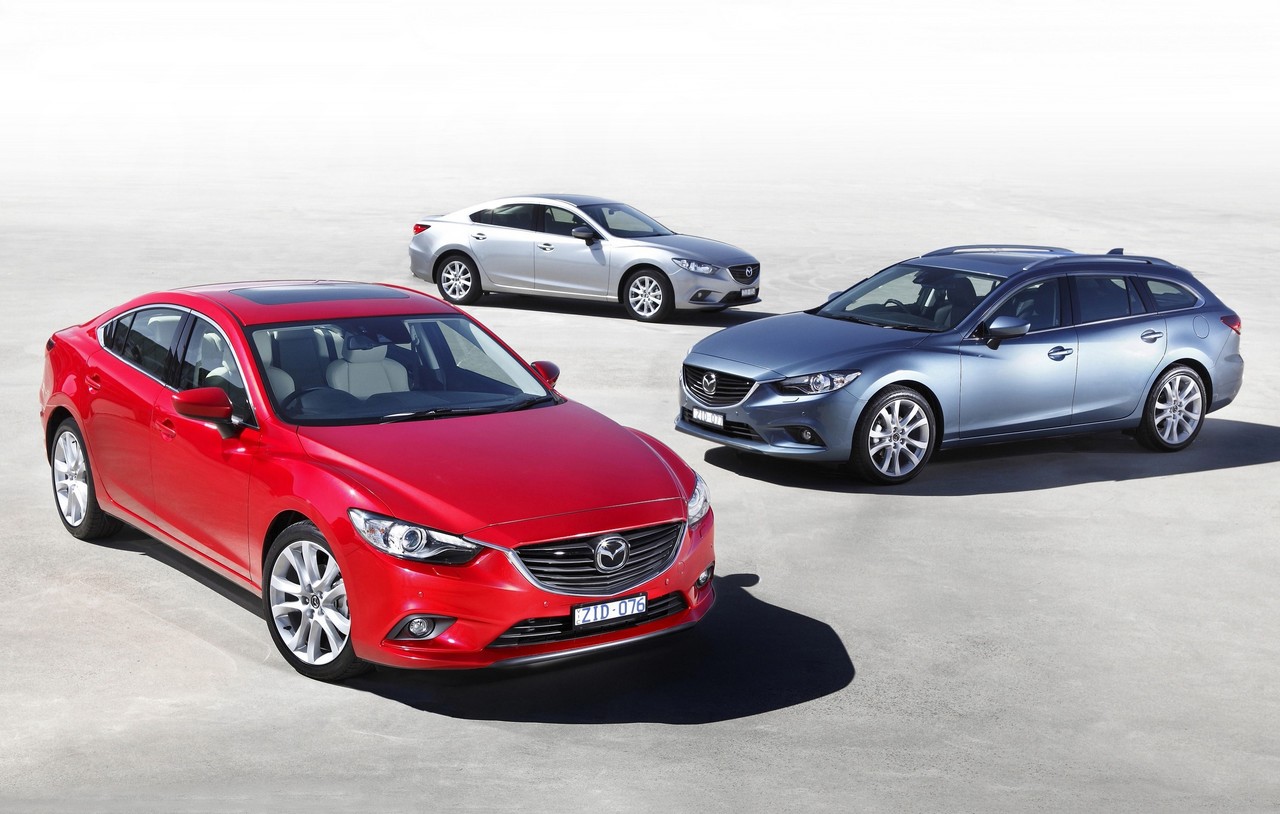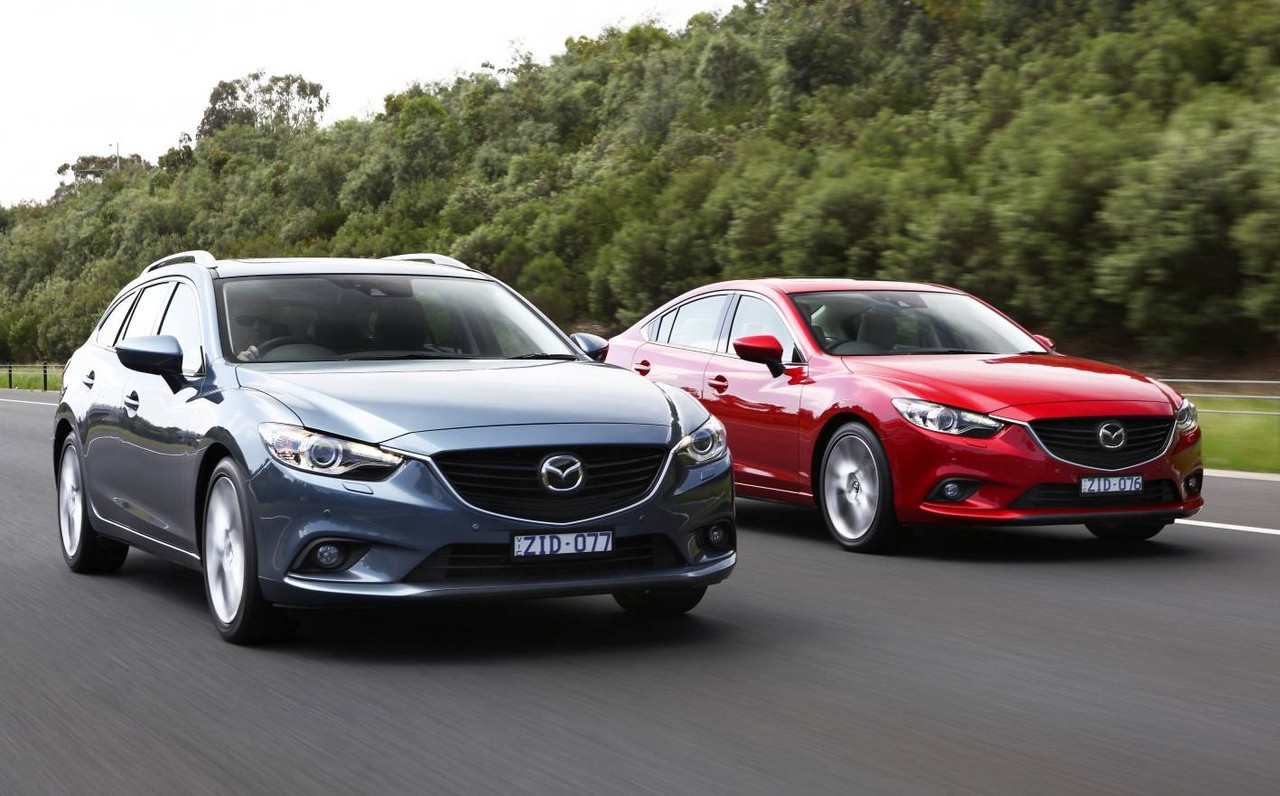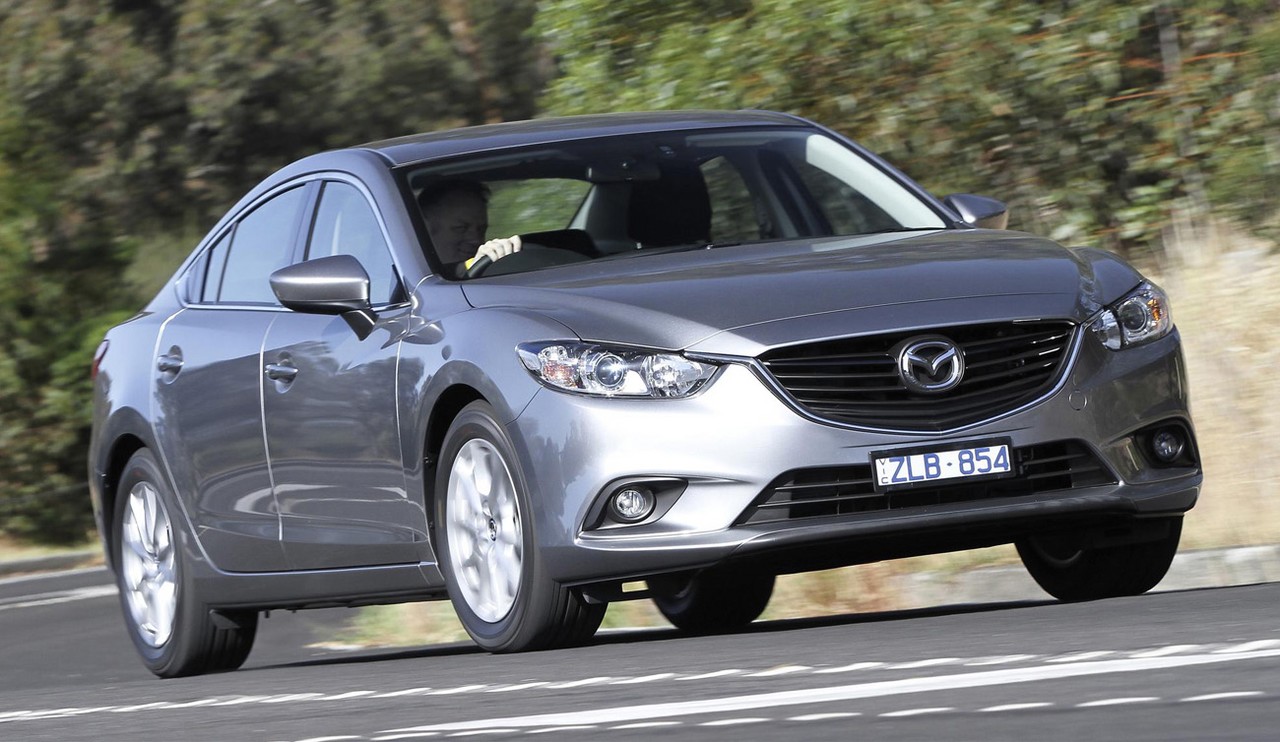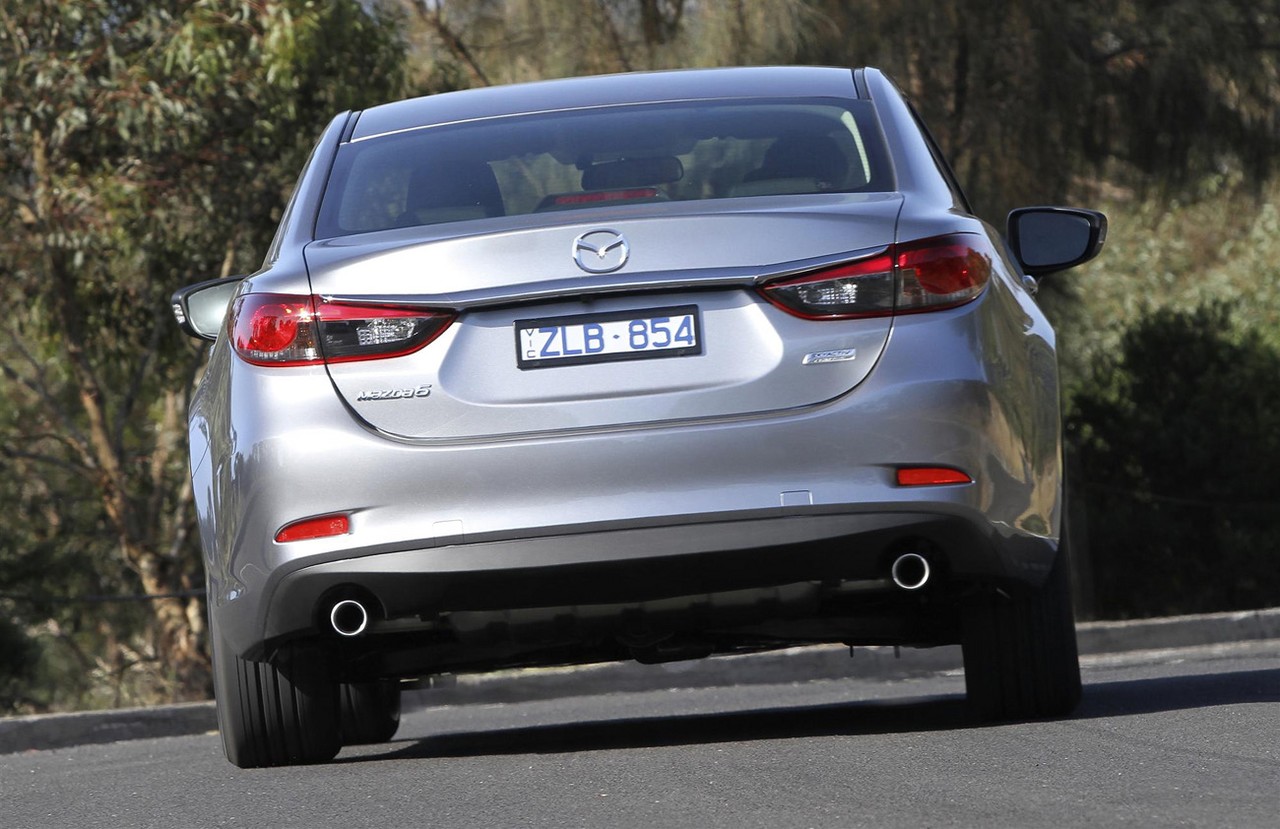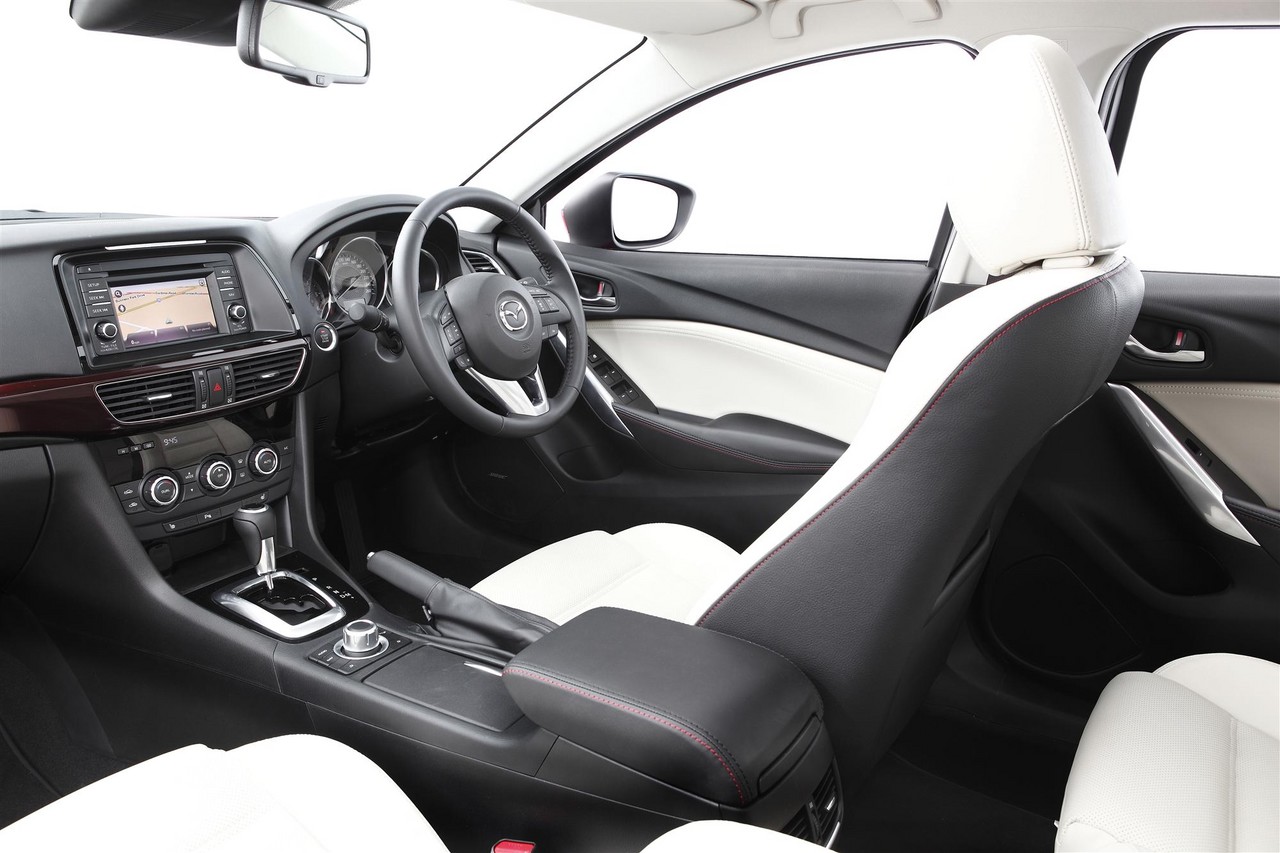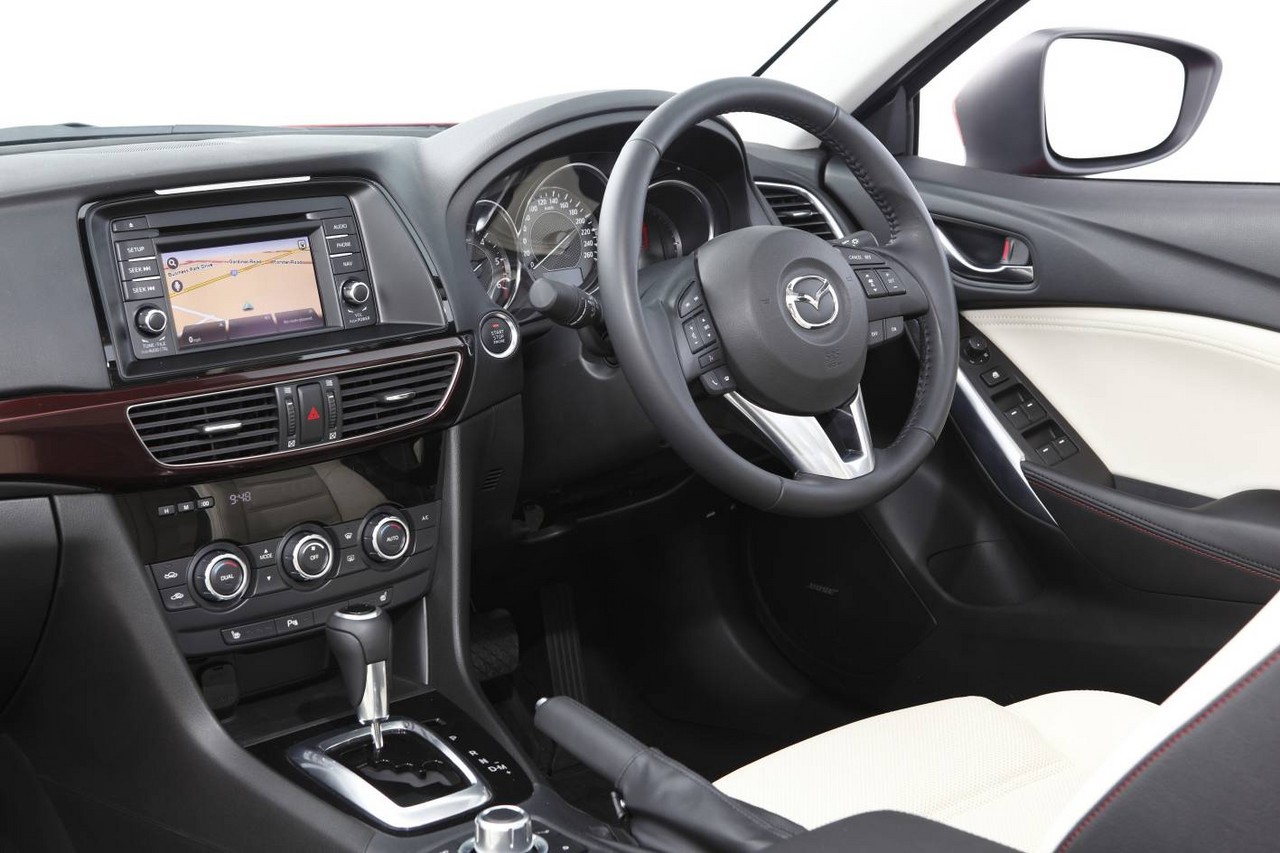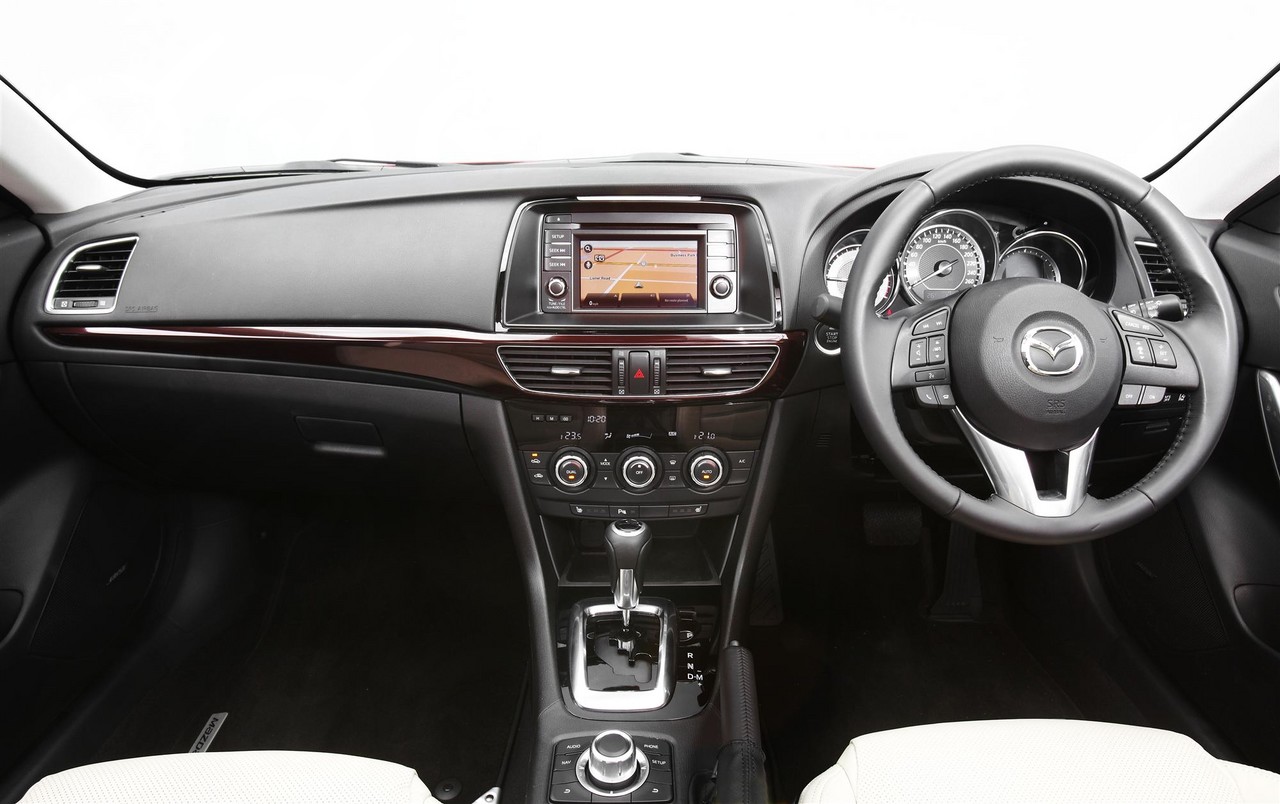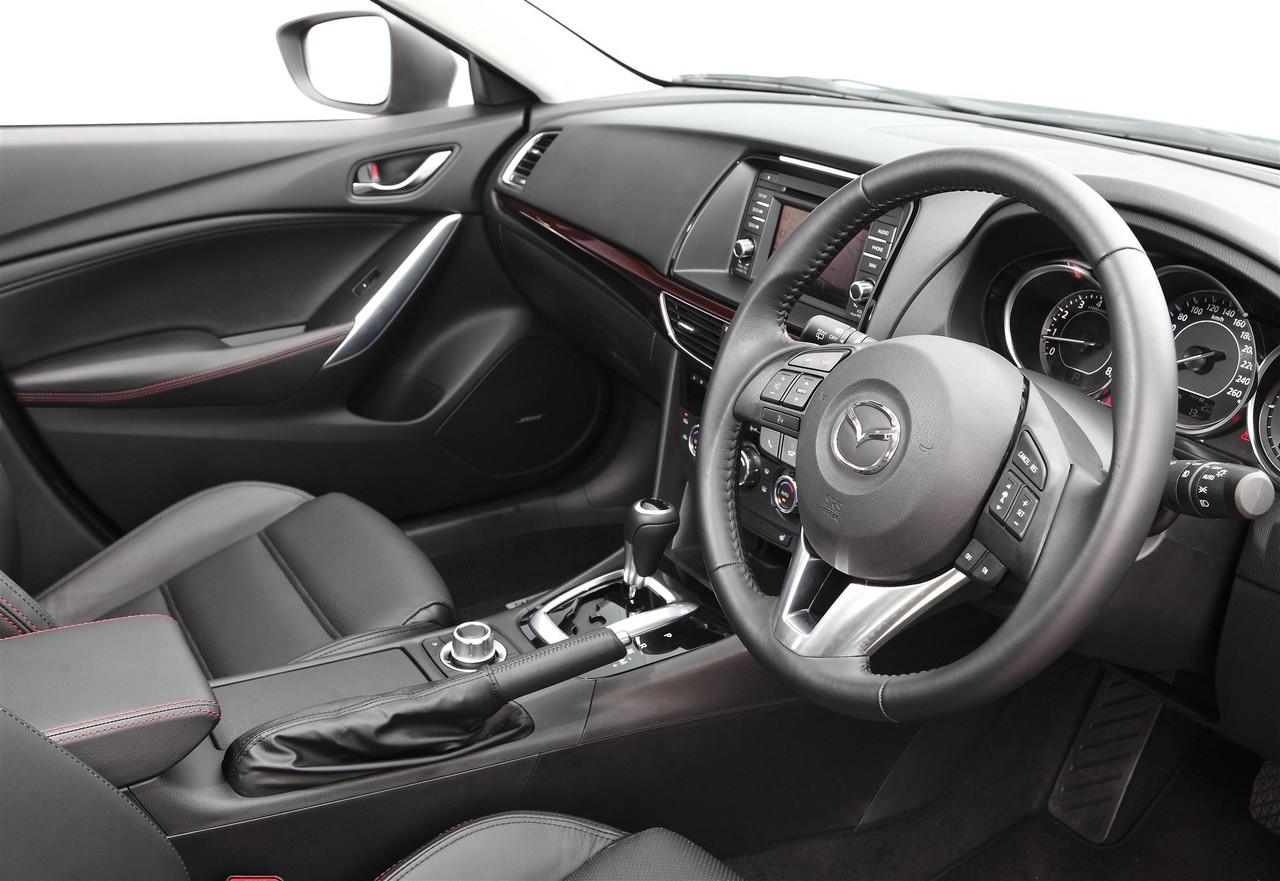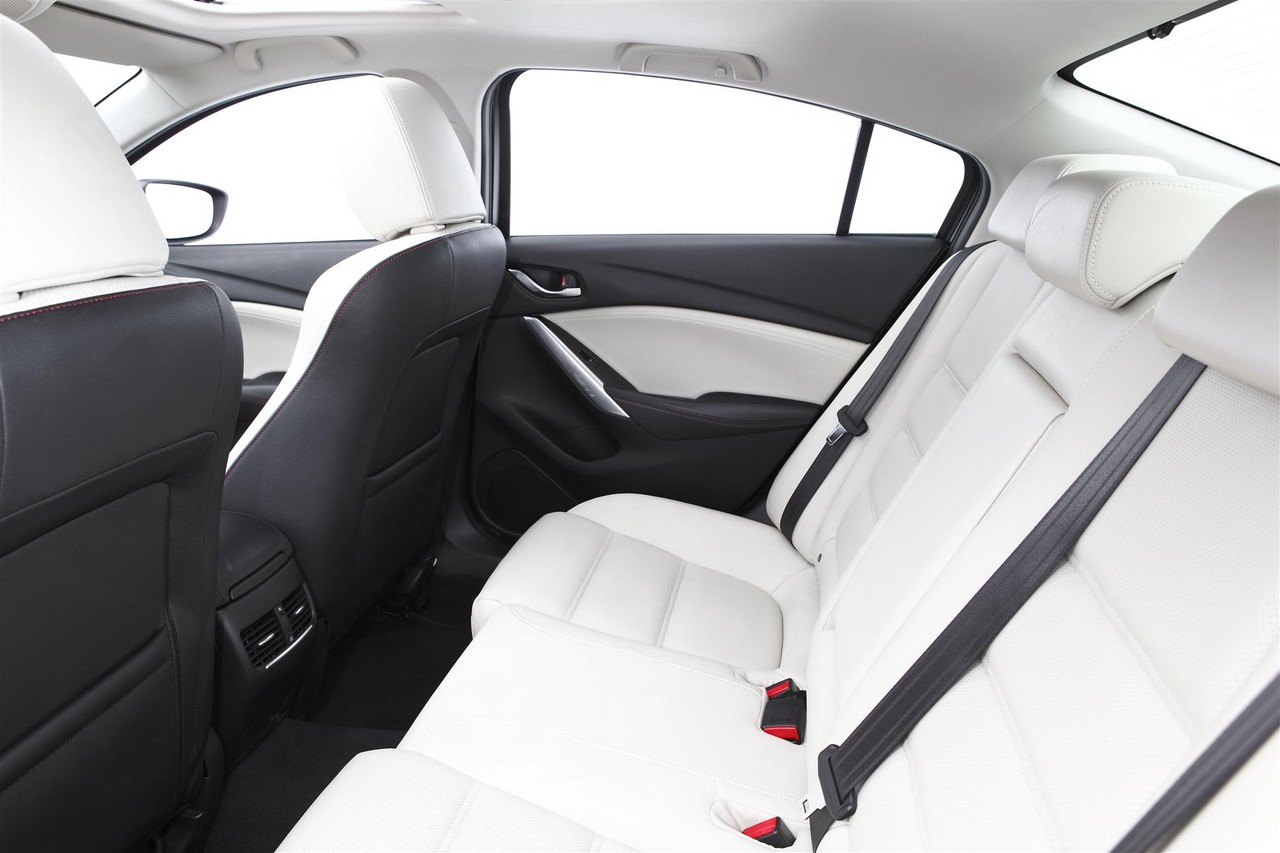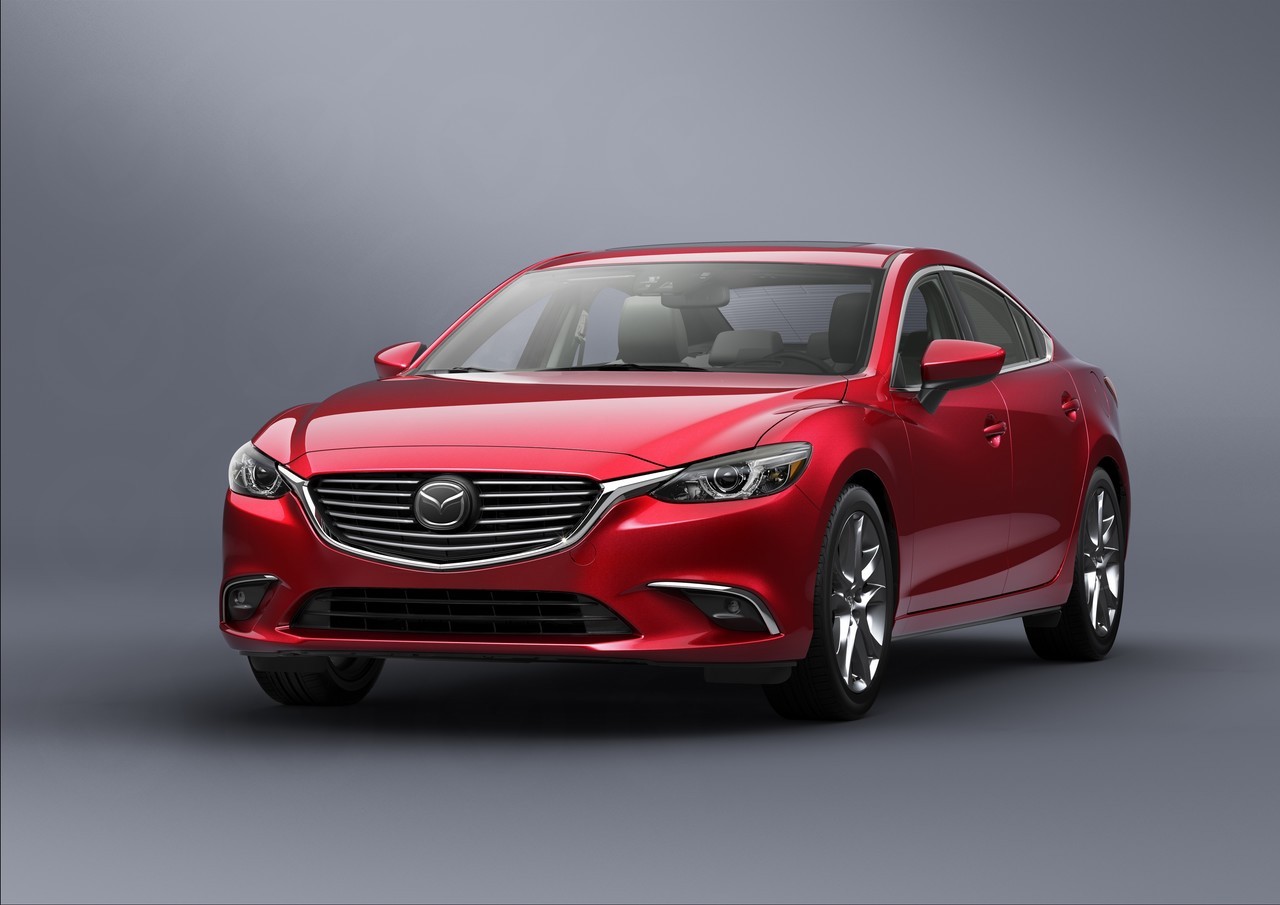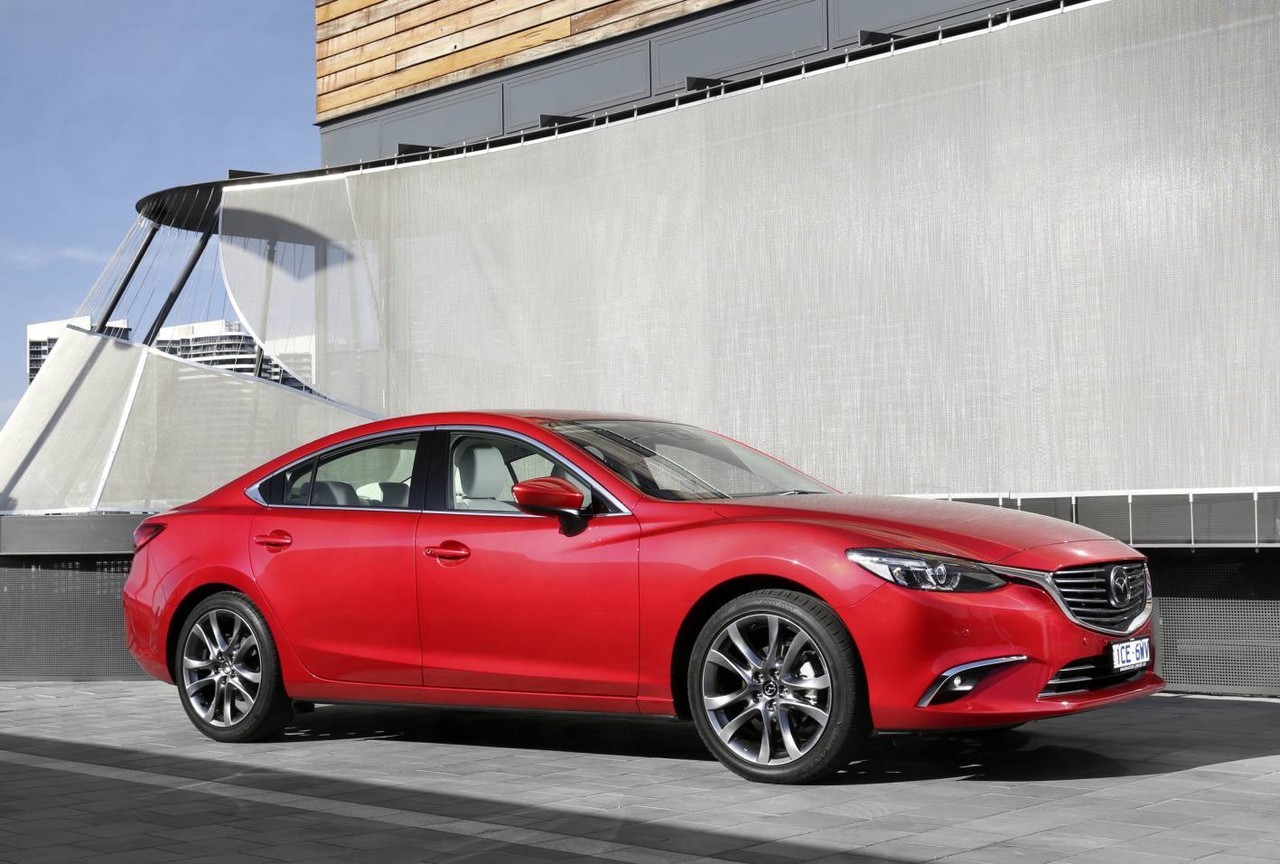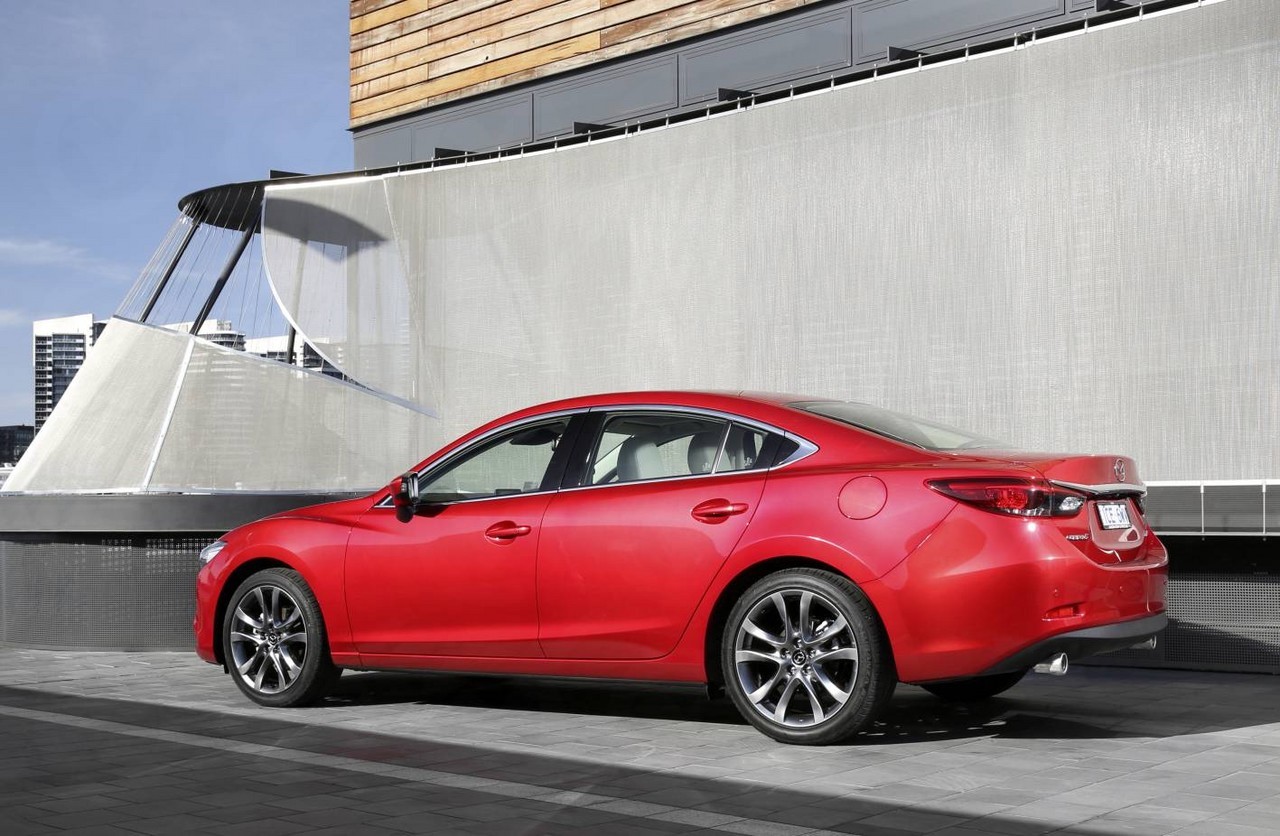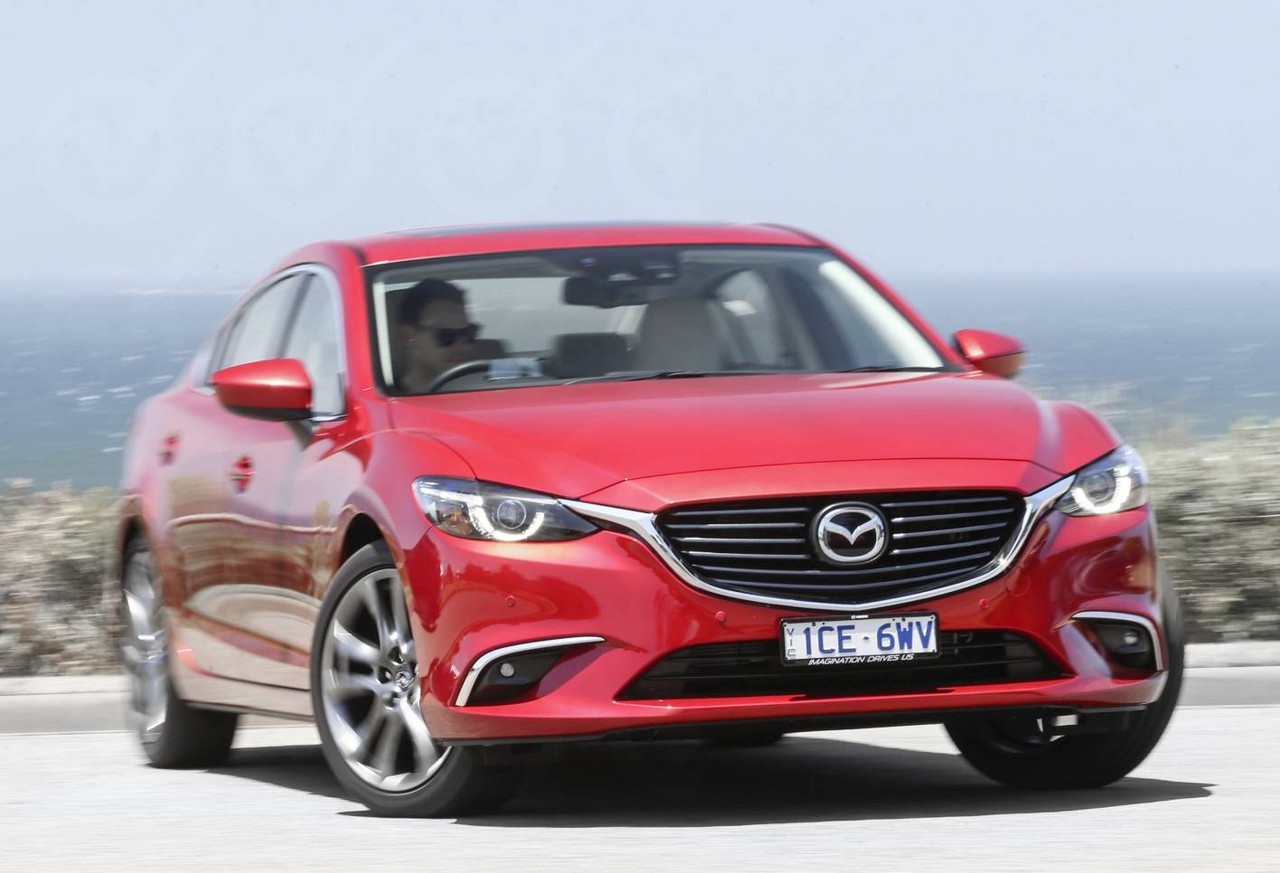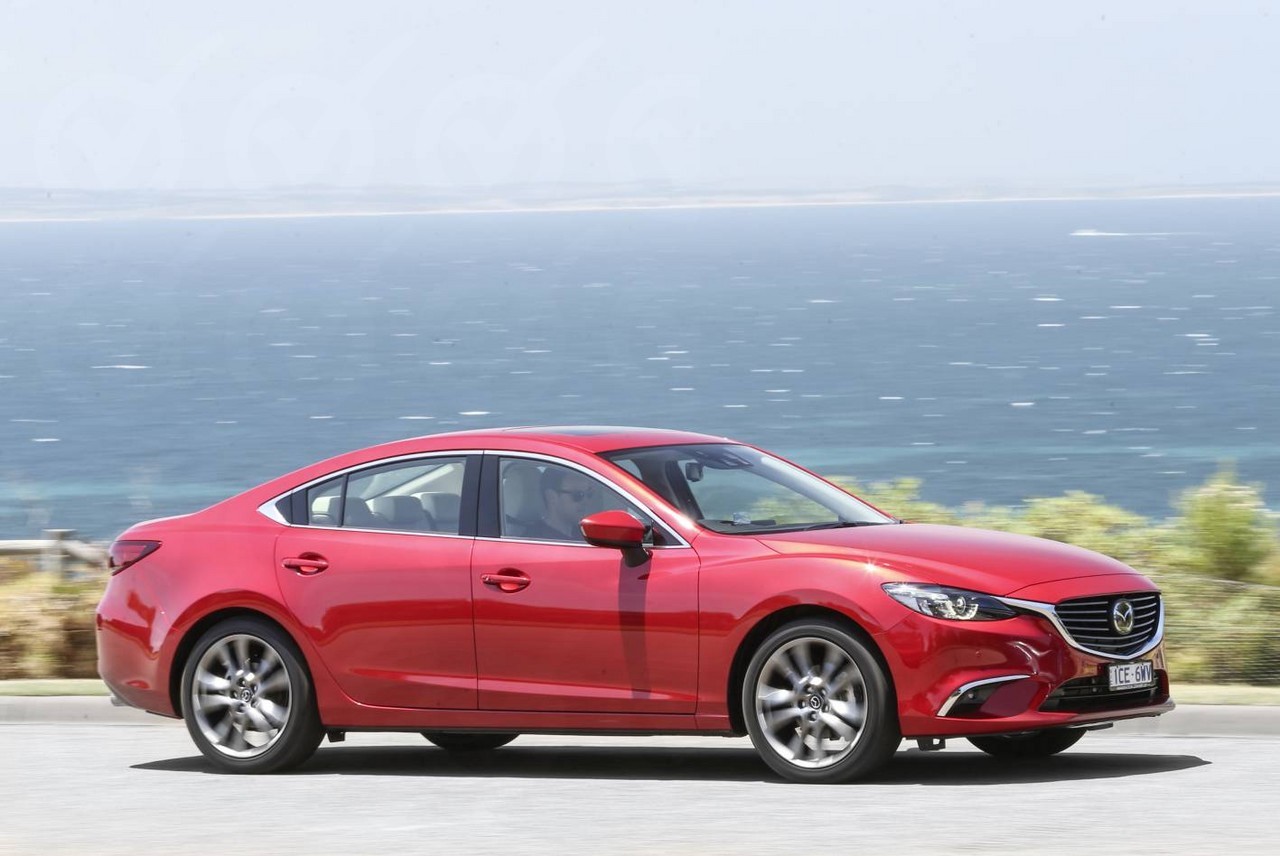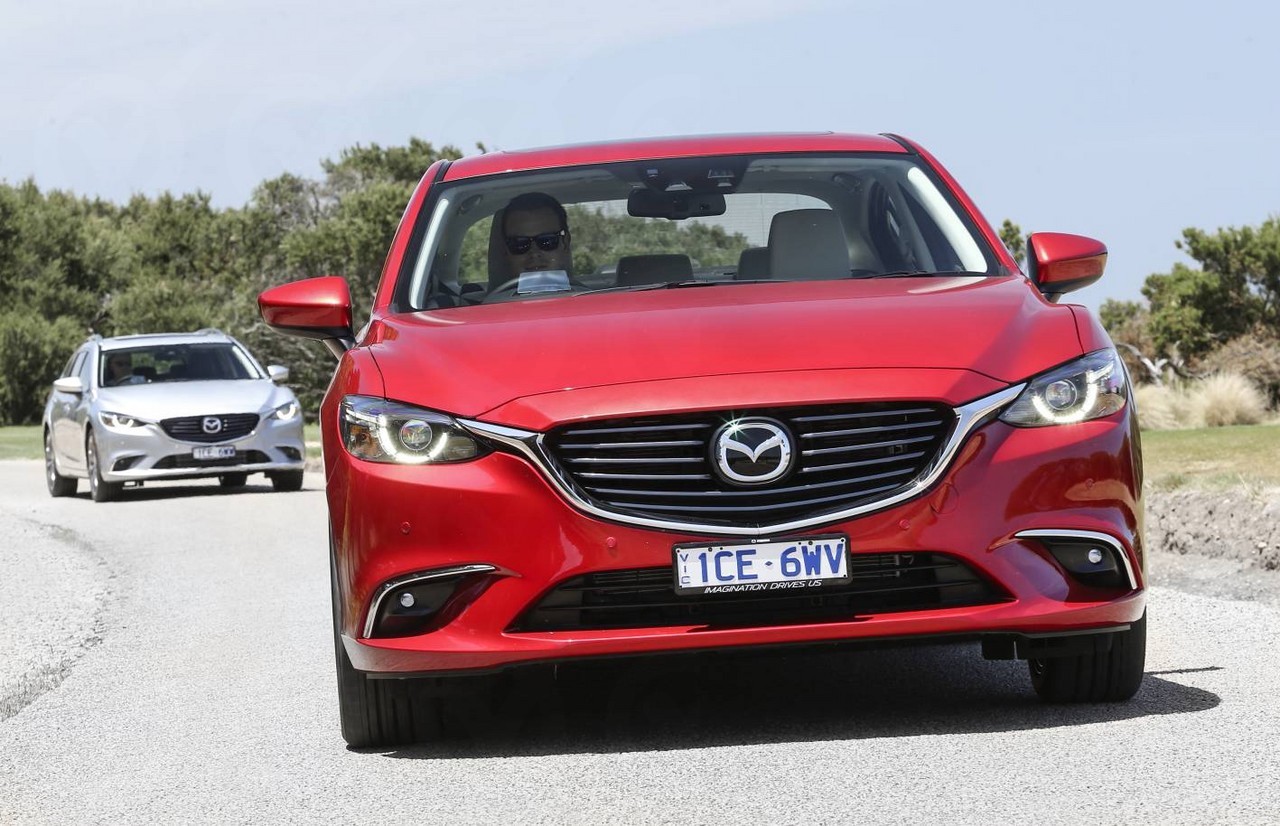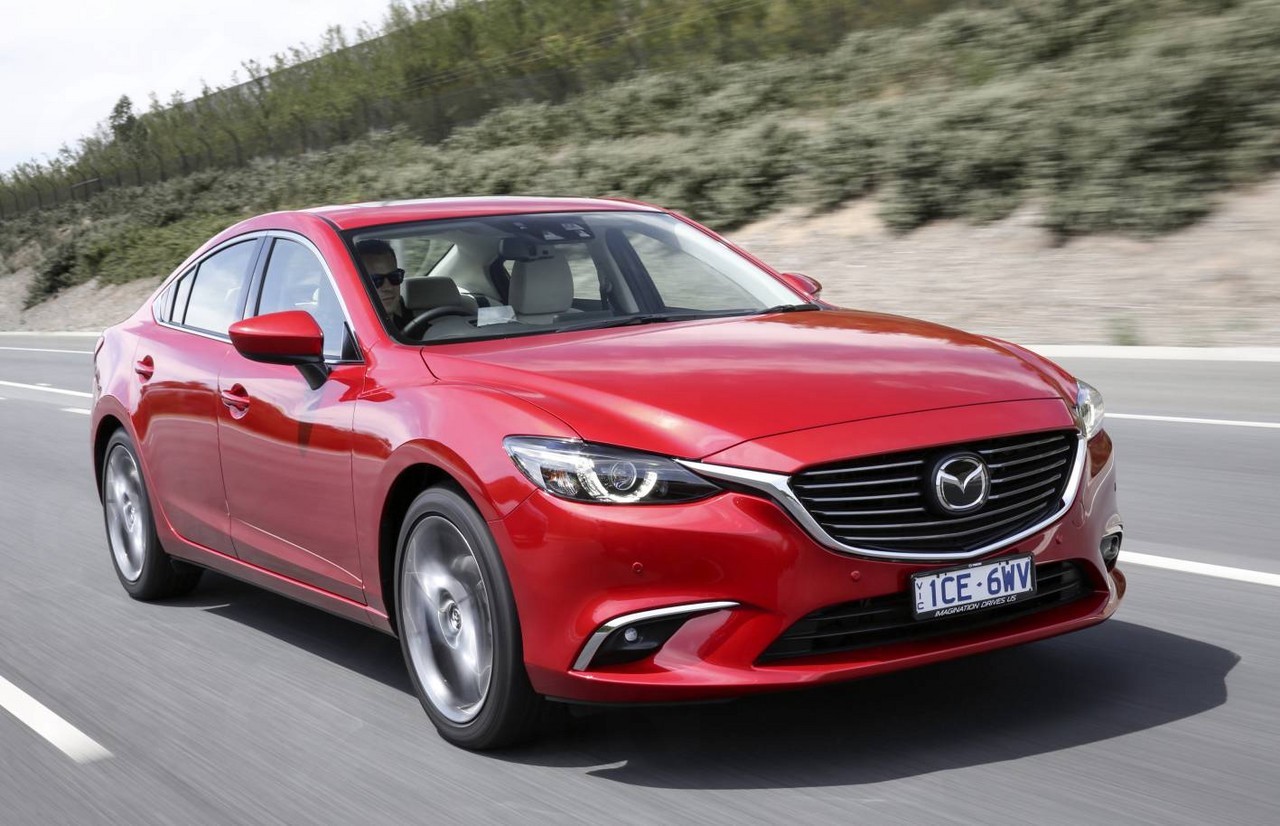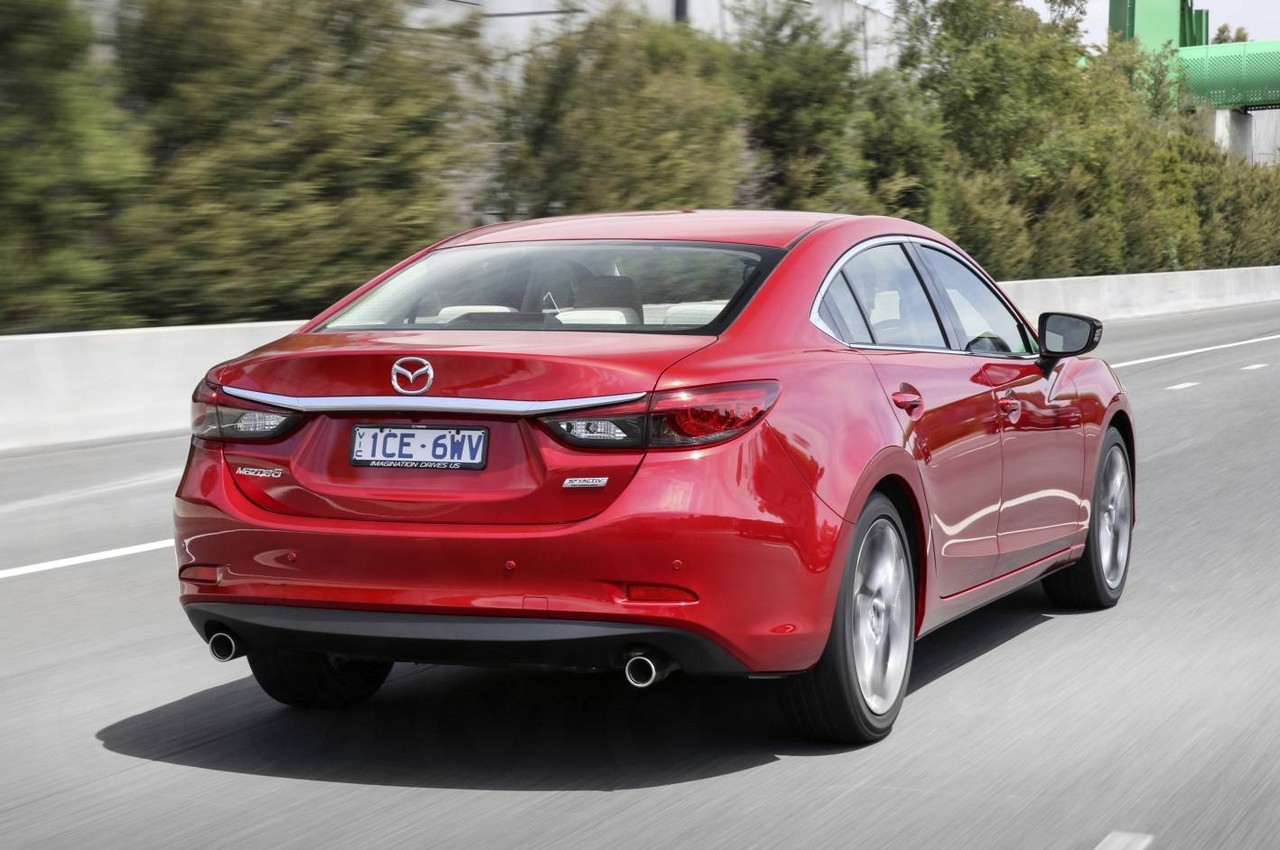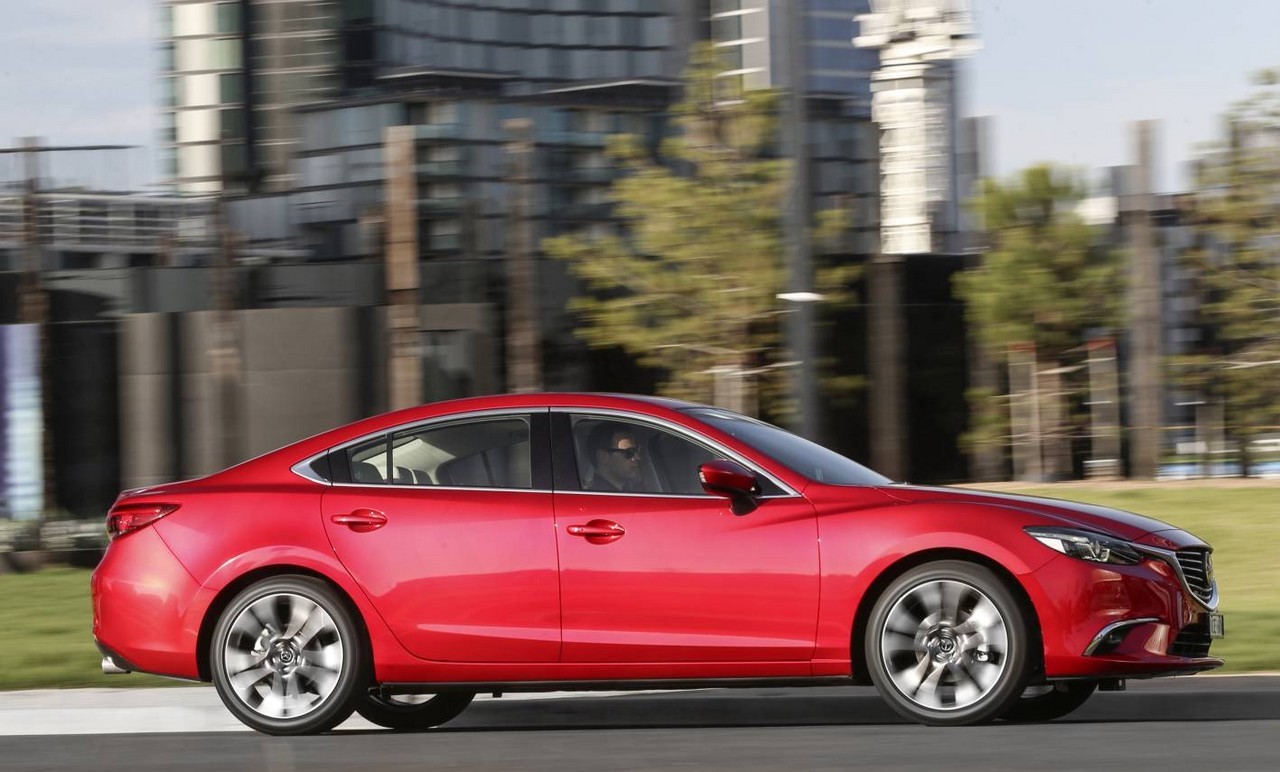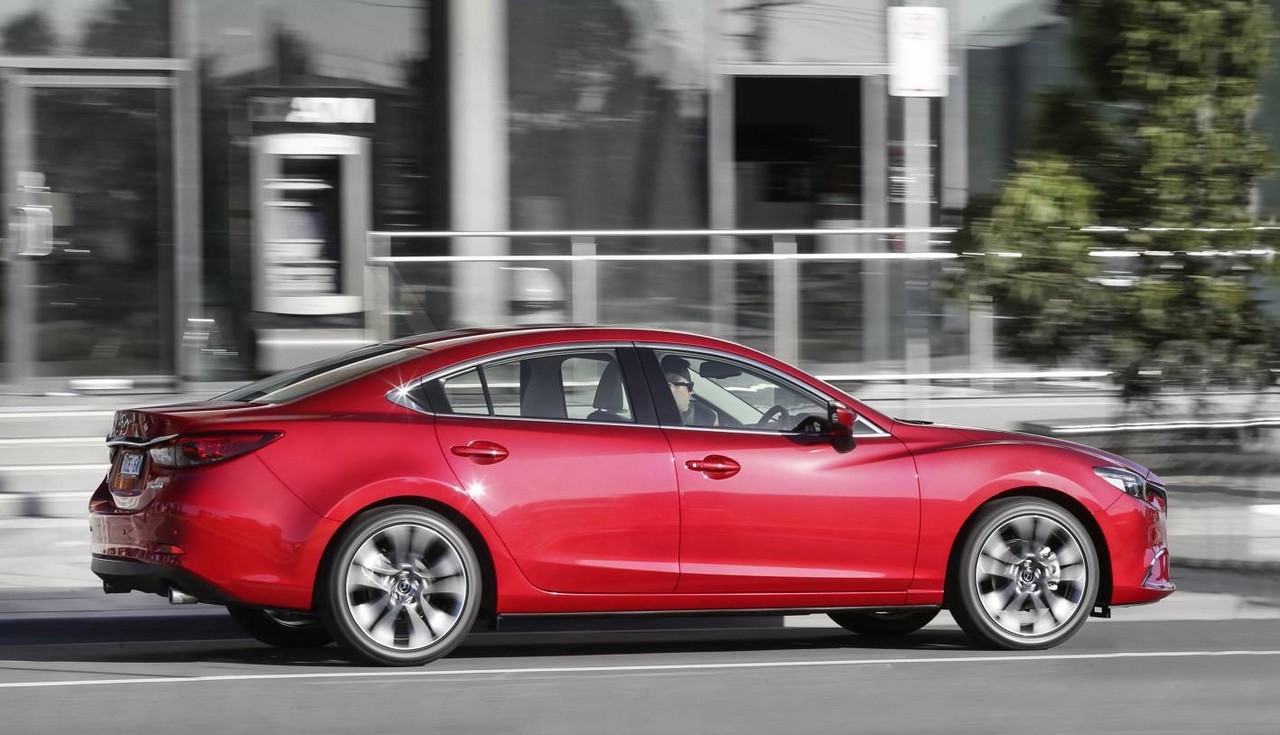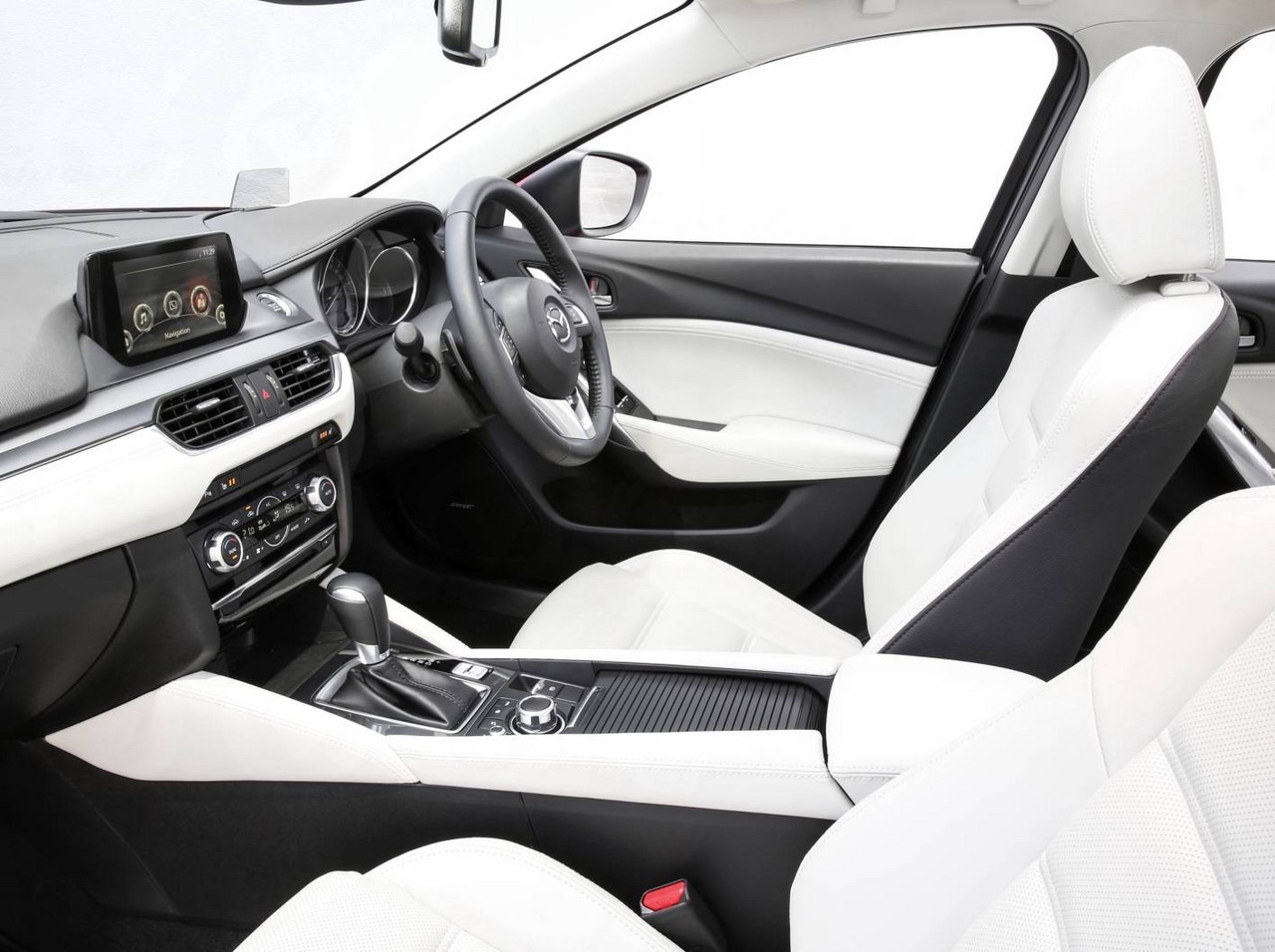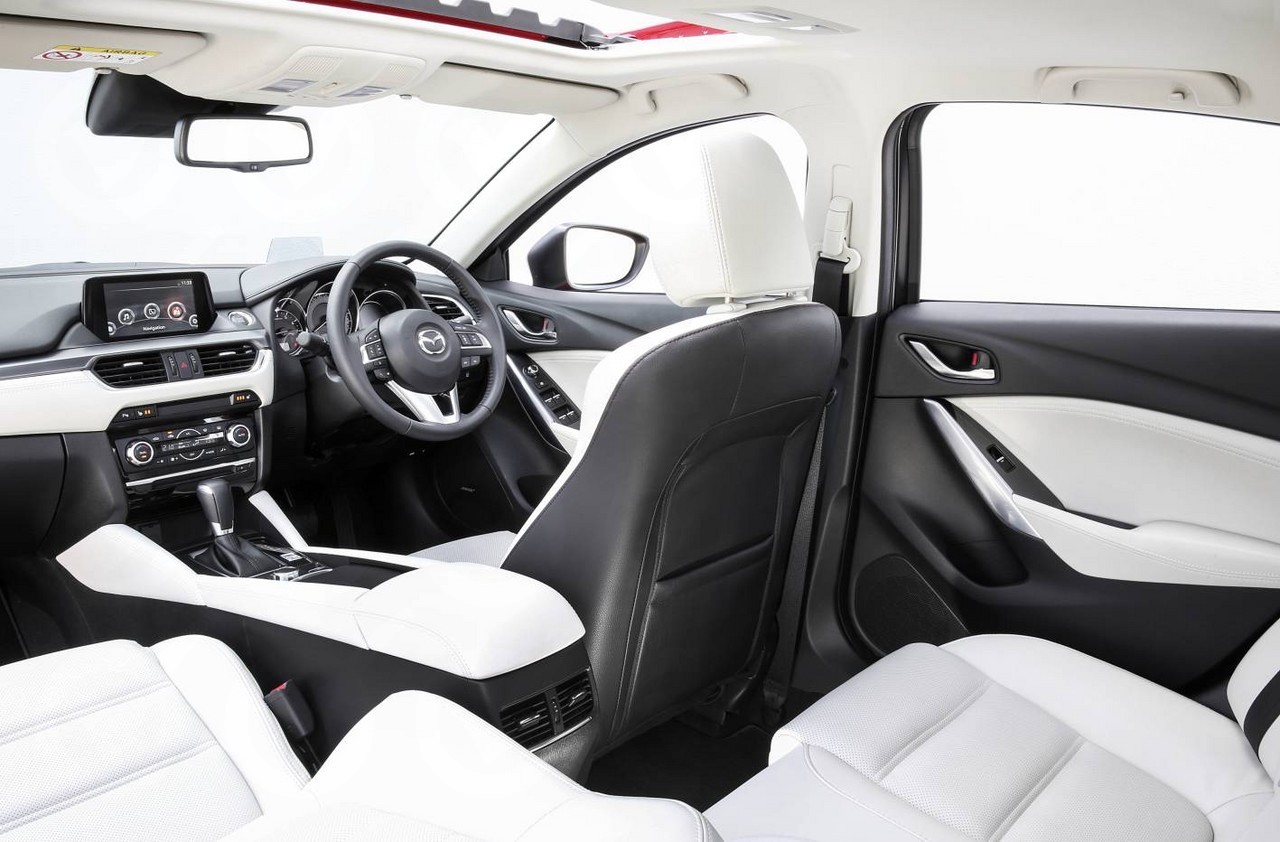
- Refined 2.5-litre petrol engine
- Responsive and economical 2.2-litre turbo-diesel engine
- High standard of interior fit and finish
- Accurate steering
- Generally impressive ride/handling balance…
- … though firm ride on 19-inch wheels
- Cabin is noisier than rivals
- Limited rear seat headroom
- Sedan has shallow boot
Review: Mazda GJ.I Mazda6 (2012-16)
Overview
Released in Australia in December 2012, the Mazda GJ Mazda6 was available as a mid-size sedan or wagon. Manufactured in Japan, the front-wheel drive GJ Mazda6 was powered by Mazda’s SkyActiv 2.5-litre petrol and 2.2-litre turbo-diesel engines.
SkyActiv-G and SkyActiv-D engines
Of the engines,
- The 2.5-litre PY-VPR ‘SkyActiv-G’ petrol engine had an aluminium alloy block and cylinder head, a balance shaft, double overhead camshafts, four valves per cylinder, variable valve timing for the intake and exhaust valves (Mazda’s ‘dual S-VT’), a 4-2-1 exhaust system with an extended manifold structure to reduce residual exhaust gas in the combustion chamber, direct injection, a special piston cavity to reduce cooling losses and a compression ratio of 13:1; and,
- The 2.2-litre SH-VPTR ‘SkyActiv-D’ diesel engine had an aluminium alloy block and cylinder head, , common-rail direct-injection, two turbochargers (a smaller turbine for low rpm and a larger turbine for more power when required) and a compression ratio of 14:1 (the world’s lowest for a diesel engine).
Both engines were mated to six-speed automatic transmissions – which could be controlled via steering-wheel gearshift paddles – and fitted with Mazda’s ‘i-stop idle-stop’ system which enabled the engine to shut down when the vehicle was stationary to minimise fuel consumption. The GJ Mazda6 was also fitted with Mazda’s newly developed ‘i-ELOOP’ system – as standard across the range – which captured kinetic energy when the driver lifted their foot off the accelerator and stored that energy in a capacitor to power the vehicle’s electrical systems (thereby reducing fuel consumption).
| Body | Variants | Engine | Trans. | Peak power | Peak torque | Fuel con.* |
|---|---|---|---|---|---|---|
| Sedan | Sport, Touring, GT, Atenza |
2.5-litre SkyActiv-G petrol I4 |
6sp auto | 138 kW at 5700 rpm | 250 Nm at 3250 rpm | 6.6 L/100 km |
| Touring, GT, Atenza |
2.2-litre SkyActiv-D turbo diesel I4 | 6sp auto | 129 kW at 4500 rpm | 420 Nm at 2000 rpm | 5.4 L/100 km | |
| Wagon | Sport, Touring, GT, Atenza |
2.5-litre SkyActiv-G petrol I4 |
6sp auto | 138 kW at 5700 rpm | 250 Nm at 3250 rpm | 6.6 L/100 km |
| Touring, GT, Atenza |
2.2-litre SkyActiv-D turbo diesel I4 | 6sp auto | 129 kW at 4500 rpm | 420 Nm at 2000 rpm | 5.4 L/100 km |
Dimensions and body
Compared to the Mazda GH Mazda6 which preceded it, the GJ Mazda6 sedan was 130 mm longer (at 4865 mm), 45 mm wider (1840 mm), 10 mm taller (1450 mm) and had a 105 mm longer wheelbase (2830 mm). Relative to its sedan counterpart, the Mazda6 wagon was 65 mm shorter (at 4800 mm), 30 mm taller (1480 mm) and had an 80 mm shorter wheelbase (2750 mm), though width was unchanged.
Significantly, the GJ Mazda6 chassis utilised a higher proportion of ultra-high tensile steel to reduce mass by approximately 30 per cent and improve torsional rigidity by 45 per cent. Other fuel-saving measures included an electric power assisted steering system and an aerodynamically optimised under-floor design which contributed to a drag coefficient of 0.27 Cd for the sedan and 0.28 Cd for the wagon.
Suspension
The Mazda GJ Mazda6 had MacPherson strut front suspension and independent, multi-link rear suspension.
Safety equipment
Standard safety equipment for the Mazda GJ Mazda6 included dual front airbags, front side airbags, full-length curtain airbags (i.e. for front and rear occupants), ABS, electronic brake force distribution, brake assist, electronic stability control, traction control and front seatbelts with pretensioners and load limiters. The Mazda6 also had an Emergency Stop Signal (ESS) which rapidly flashed the rear brake lights in the event of emergency braking from speeds above 50 km/h in order to warn trailing vehicles.
The Mazda6 Atenza was further equipped with Mazda’s ‘i-ACTIVSENSE’ safety technologies:
- Forward Obstruction Warning (FOW) alerted the driver when the vehicle was too close to the vehicle ahead and at risk of a collision;
- Smart Brake Support (SBS) used a near-infrared beam sensor to prevent, or minimise, the severity of frontal collisions – at speeds between 15 km/h and 145 km/h – by automatically applying the vehicle’s brakes if the driver failed to do so;
- Blind Spot Monitoring (BSM) operated at speeds in excess of 30 km/h and detected vehicles approaching from behind or in the driver’s blind spot (on either side of the vehicle);
- Lane Departure Warning System (LDWS) used a camera to detect lane markings and warn the driver of unintentional lane departures when travelling at speeds of 65 km/h or above;
- Rear Cross Traffic Alert (RCTA) would warn the driver of oncoming traffic when they were reversing from a parking space; and,
- Radar Cruise Control operated at speeds above 30 km/h and maintained a safe distance from the vehicle ahead, including autonomous application of the brakes when required.
From April 2014, the Mazda6 Atenza was fitted also fitted with Smart City Brake Support (SCBS) as standard; operating at speeds between 4 km/h and 30 km/h, SCBS could provide automated braking to prevent, or reduce the severity of, low-speed collisions.
Brakes
The Mazda GJ Mazda6 had 297 mm by 28 mm ventilated front brake discs and 278 mm by 10 mm solid rear discs.
Euro NCAP testing
In Euro NCAP testing , the Mazda GJ Mazda6 wagon received a five star safety rating which included a 92 per cent adult occupant protection rating and a 77 per cent child occupant protection rating. In the offset crash test, occupant protection was generally good though chest protection was only rated as ‘adequate’. In the side impact test, maximum points were awarded; in the more severe pole test, however, chest protection was also assessed as adequate. Under ANCAP’s methodology , this testing resulted in a five star adult occupant protection rating with a score of 35.44 out of 37.
Features: Mazda6 Sport
Standard features for the Mazda GJ Mazda6 Sport included 17-inch alloy wheels with 225/55 R17 97V tyres, a six speaker sound system with a CD player, MP3/WMA compatibility, auxiliary inputs (3.5 mm/USB/iPod) and Bluetooth audio streaming, a TomTom satellite navigation system, cruise control, front fog lights, automatic headlights, a reversing camera, 60/40 split and folding rear seats, Bluetooth mobile phone connectivity, a leather-wrapped steering wheel and gear shift knob, steering wheel audio controls, remote central locking, power windows and heated mirrors, tilt and telescopic steering wheel adjustment, push-button start, a trip computer and an immobiliser. Wagon models were also fitted with flat folding rear seats, a rear 12 volt power outlet, tonneau cover, cargo net, rear wiper, spoiler and roof rails.
Features: Mazda6 Touring
Compared to the Mazda6 Sport, the Mazda6 Touring was further equipped with a 231 watt Bose sound system with eleven speakers, an eight-way power adjustable driver’s seat, a four-way power adjustable front passenger seat, leather seats, driver seat memory settings and parking sensors (front and rear).
Features: Mazda6 GT
Relative to the Mazda6 Touring, the Mazda6 GT added 19-inch alloy wheels with 225/45 R19 92W tyres, heated front seats, bi-xenon headlights, daytime running lights, a proximity key and an auto-dimming rear view mirror. The bi-xenon headlights also included Mazda’s Adaptive Front Lighting System (AFS) which would predict the vehicle’s direction – based on steering input and vehicle speed – and turn the headlights in that direction.
Features: Mazda6 Atenza
In addition to its safety technologies, the Mazda6 Atenza was distinguished by its High-Beam Control (HBC) function which used a sensor to detect on-coming vehicles and automatically changed the headlights between high- and low-beam to avoid blinding other drivers.
Brochure
Related links
- Press Kit: Mazda GJ Mazda6 (December 2012)
- Specifications: Mazda GJ Mazda6 (December 2012)
- Mazda News: More safety options available on Mazda6 (April 2014)
Review: Mazda GJ.II Mazda6 (2014-16)
Overview
Commencing production in November 2014 and officially released in Australia in January 2015, the Mazda GJ Series II (GJ.II) Mazda6 introduced noise reduction measures and revised suspension. Visually, the GL Mazda6 could be identified by its new front grille and ‘signature’ front wings and new headlights; new Sonic Silver Metallic and Titanium Flash Mica paint finishes were also introduced. The range, however, was unchanged.
Inside, the Mazda GJ.II Mazda6 had a re-shaped instrument panel and floor console, MZD Connectivity system with a seven-inch colour touch screen (fitted as standard), smaller gaps between interior components and new seat structures for greater support. For models with petrol engines, the automatic transmission gained a ‘Drive Selection’ function which enabled the driver to engage a ‘Sport’ mode.
| Body | Variants | Engine | Trans. | Peak power | Peak torque |
|---|---|---|---|---|---|
| Sedan | Sport, Touring, GT, Atenza |
2.5-litre SkyActiv-G petrol I4 |
6sp auto | 138 kW at 5700 rpm | 250 Nm at 3250 rpm |
| Touring, GT, Atenza |
2.2-litre SkyActiv-D turbo diesel I4 | 6sp auto | 129 kW at 4500 rpm | 420 Nm at 2000 rpm | |
| Wagon | Sport, Touring, GT, Atenza |
2.5-litre SkyActiv-G petrol I4 |
6sp auto | 138 kW at 5700 rpm | 250 Nm at 3250 rpm |
| Touring, GT, Atenza |
2.2-litre SkyActiv-D turbo diesel I4 | 6sp auto | 129 kW at 4500 rpm | 420 Nm at 2000 rpm |
Body and sound insulation
Mazda claimed the amount of noise transmitted into the cabin of the Mazda GJ.II Mazda6 was reduced by approximately 10 per cent when driving on rough roads and 25 per cent on highways – this was achieved through the following measures:
- A sealant was added between the vehicle’s body and undercover (positioned beneath the vehicle’s floor);
- Additional undercoating;
- Additional insulation material behind the mudguards;
- Microfibre floor mats for better sound absorption;
- A new layer for the dashboard insulator; and,
- Greater coverage and thickness of vibration damping material on the vehicle floor.
Suspension
For the Mazda GJ.II Mazda6, Mazda claimed that optimised bushing shapes for the front lower arms and a new structure for the front and rear dampers provided greater ride comfort. Specifically,
- For the front dampers, the new piston had an integrated initial valve that controlled the opening pressure of the valve, while high-friction oil was used to give a slow stroke while also providing positive damping force; and,
- The diameter of the rear damper pistons was increased (from 25 mm to 30 mm). Furthermore, the shape of the valve at the bottom of the piston was revised and the size of the oil passage enlarged to reduce fluid pressure loss.
Beyond this, the following changes were introduced to reduce vibration and noise:
- Higher capacity dynamic dampers for the front suspension struts;
- The introduction of dynamic dampers for the rear trailing arms; and,
- The introduction of hollow stabiliser bars.
Safety equipment
For the Mazda GJ.II Mazda6, i-ACTIVSENSE technologies for the Mazda6 Atenza were extended to include:
- A rearward detection for Smart City Brake Support (SCBS F/R). For SCBS Reverse, the system operated at speeds between 2 km/h and 8 km/h and used ultrasound sensors in the rear bumper to detect obstacles up to two metres behind the vehicle. When an obstacle was detected and a high risk of collision was determined, the brakes would be applied automatically to avoid or reduce the severity of the collision;
- Lane-keep Assist System (LAS): used a forward-sensing camera to monitor lane markings on the road surface and assisted the driver to stay in their lane by providing steering torque assistance. The driver could choose from ‘Early’ or ‘Late’ settings to adjust the level of assistance and the timing of its operation. In the ‘Early’ setting, for example, the system provided continuous steering assistance to keep the vehicle in the centre of its lane;
- Driver Attention Alert (DAA): operating at speeds above 65 km/h, the DAA system would initially observe driver behaviour – such as steering wheel operation, vehicle speed and lane positioning – for 20 minutes to establish a benchmark. The DAA system would then monitor driver behaviour for signs of fatigue and recommended rest breaks if detected. Alerts would also be issued if the driver had been driving continuously for more than two hours; and,
- Adaptive LED Headlamps (ALH): combined ‘Glare-free High Beam’, which controlled the illumination coverage of the high beams, and ‘Wide-range Low Beam’, which expanded the area of illumination.
From February 2016, however, the following i-ACTIVSENSE safety technologies were fitted as standard to the Mazda6 Sport, Touring and GT:
- Blind Spot Monitoring (BSM);
- Rear Cross Traffic Alert (RCTA); and,
- Smart City Brake Support – Forward (SCBS-F).
As part of the update, these models were also fitted with a rear-view mirror with auto-dimming function. From February 2016, the Mazda6 Touring and Mazda6 GT were also fitted with Smart City Brake Support – Reverse (SCBS-R).
Features: Mazda GJ.II Mazda6
Standard features for the Mazda GJ.II Mazda6 were extended to include Mazda’s ‘MZD Connect’ in-car connectivity system which had a seven-inch touch screen and satellite navigation, and an electric parking brake.
The Mazda6 GT and Atenza were also equipped with Mazda’s ‘Active Driving Display’, a head-up display which projected vehicle speed, cruise control settings and navigation information.
For a complete list of features for the Mazda GJ.II Mazda6, please refer to the brochure below.
Brochure
